Culture of African catfish, Clarias gariepinus, has received considerable attention since the early 1970s and 1980s (Clay, 1981). African catfish is a suitable alternative to tilapia in subsistence fish farming in Africa and using low grade feed composed of some local agricultural by-products, the yields of catfish from ponds could be as much as 2.5 times higher than those of tilapia (Hogendoorn, 1983). Some problems are facing the wide spreeding of catfish culture, e.g. fry cannibalism via jumpers (Steffens, 1989). Therefore, the present research aimed to study the possibility of reducing cannibalism among newly hatched fry by grading.
Materials and Methods
The following Figures illustrate stripping of female catfish, testes evisceration from their males, egg fertilization and incubation until hatching.
Stripping a Female
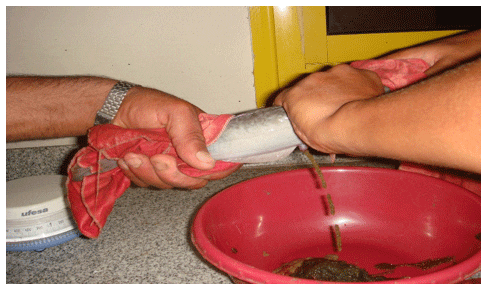
Testes evisceration

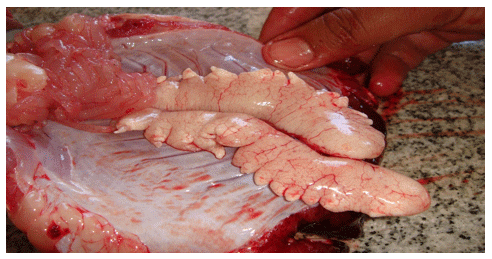
Egg fertilization
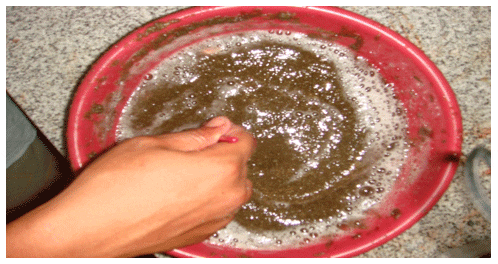
Separate fertilized eggs
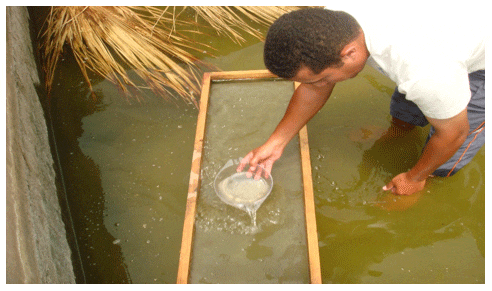
The chosen fry (9000, with an initial body weight of 0.38 g) was divided into three treatments. Each treatment has three replicates. Fry were put in 9 hapas, one thousand fry in each hapa (2 X 1X 0.8 m). The fry were fed on Mach (40 % crude protein, 6.4 % crude fat, 5.23 %crude fiber, and 4280 kcal/kg gross energy, from Hendrix Egypt, Al-Sharkeia governorate, consisted of 25.2 % fish meal (72% CP), 21.3% soybean meal (44% CP), 13.5% rice bran, 13.2% wheat bran, 13.2% corn gluten (60% CP), 10.4 % yellow corn, 1.7 % dicalcium phosphate, 0.7 % lime stone, 0.5 % soya oil, and 0.3 % vitamins and minerals mixture). This experiment continued for 4 weeks. Average body weight was recorded each week and water quality parameters were measured too. The fry, which selected after each grading were removed into a separate hapa.
T1: without grading.
T2: grading each 3 days.
T3: grading each 7days.
Grading technique: it means the separation (by eye observation) to the biggest fry from population.
Water quality analysis: Water quality parameters (pH-values, dissolved oxygen concentration, and temperature degrees) were measured weekly (Abdelhamid, 1996, 2009a and b). Water temperature in degree centigrade was recorded by using a thermometer. The pH value of water was measured using an electric digital pH meter model (ComGo pH & EC, HANNA). Dissolved oxygen was determined weekly using an oxygen meter model (HANNA instruments waterproof DO meter, Romania).
Statistical analysis:
The obtained numerical data from the first experiment were statistically analyzed using SAS (2001) for one-way analysis of variance. Differences between comparisons among treatment means were made by using Duncan multiple range test (Duncan, 1955).
Results and Discussion
Water quality parameters:
Table 1 illustrates the means of water quality criteria measured in the grading ponds from 13/7 until 3/8 including pH values, temperature, and dissolved oxygen (DO) at 6 am and 6 pm, respectively. The values of water parameters are within the acceptable ranges recommended for pisciculture (Abdelhamid, 1996 and 2009b). However, the optimum growth of African catfish requires 28 – 30 oC, < 5 ppt salinity, < 15 mg/l dissolved oxygen, 6.5 – 9.0 pH, and 50 – 100 mg/l hardness in the rearing water (Chapman, 2000).

Body weight and survival rate:
The effect of grading intervals on the average body weight of the African catfish fry as well as on their survival rate (SR) throughout four weeks was studied in this part of the experiment. Data given in Table 2 cleared that there were no significantly (P ≥ 0.05) differences among treatments neither in the initial body weight nor at 1st week. Yet, there were significant differences among treatments at the following weeks (2, 3 and 4) in favor of T1 (control without grading) at the 4th week because of the low number of fry remained (12 from 1000), since the SR of this treatment was calculated as 1.2 %. However, the middle frequency of grading (T2: grading each 3 days) realized the best SR of 49.17 % after 4 weeks and the highest fry body weight at the 2nd week. Whereas, the low body weight of fry at the 3rd and 4th weeks in T2 and T3 may be due to that the jumpers number had increased only at these intervals and were very big and prey the large size of fry (Table 3) so, decreased the mean body weight of the rest fry (small ones without jumpers and the consumed ones). Therefore, the body weight at the 2nd week was significantly high for the homogenisity in the fry body weight. So, with middle labor (grading the newly hatched fry every 3 days) and economic efforts without great stress on the fry, may be able to elevate the SR by 41 and 27 times than without grading (T1) or grading each 7days (T3), respectively. Therefore, the economic efficacy (from selling the fry) could be improved by the same rate.
Appelbaum and Kamler (2000) recommended light restriction as a simple, low-cost technique for intensification of production of C. gariepinus stocking material. Since in dark, the ratio of total metabolism to body growth was depressed, hence in the dark, energy used for locomotors activity may have been low, leading to increased investment in growth. Therefore, fish reared in dark were larger than those reared in light.
Baras and d'Almeida (2001) found that cannibalism in mixed groups was intermediate between those in pure progenies, and was positively correlated (R2=0.803, P≤0.01) with initial size heterogeneity, irrespectively of fish origin. During the larval rearing trials for 30 days for African giant catfish, Heterobranchus bidorsalis, survival rates ≥82% were achieved (Adebayo and Fagbenro, 2004).
However, Coulibaly et al. (2006) reported that the main constraint of the culture of the African catfish Heterobranchus longifilis remains the high mortality rate due mainly to cannibalism. Results showed that all the parameters (mortality, cannibalism, survival, final weight variation coefficient, and apparent feed conversion ratio) were influenced by the stocking densities. Higher final mean weight, mean daily weight gain, and survival and lower final weight variation coefficient, cannibalism, mortality, and apparent feed conversion ratio were recorded at the lowest stocking densities (6 and 12 fish/m3).
Van de Nieuwegiessen et al. (2009) mentioned that previous studies on the effects of stocking density on the behavior of African catfish have shown that at low densities, especially directly after restocking of tanks, increased aggression might occur. This aggression may directly affect the welfare of the fish. In addition, the resulting skin damage may also lead to the release of chemical alarm cues from the skin of the fish, possibly acting as a secondary stressor in a farming situation.
However, El-Gaedy (2009) concluded that the dietary requirements of catfish fry were (40% crud protein and 8% oil) and for fingerlings were (35% crud protein and 8% oil) in terms of growth performance and economic evaluation. Therefore, the diet used in this experiment contained 40% crude protein.From the obtained results, it could conclude the beneficial use of commercial African catfish hatcheries to the middle frequency of grading (grading hatched fry each 3 days), which realized the best survival rate and the highest fry body weight than without grading or grading each 7 days, respectively. Therefore, the economic efficacy (from selling the fry) could be improved by the same rate.
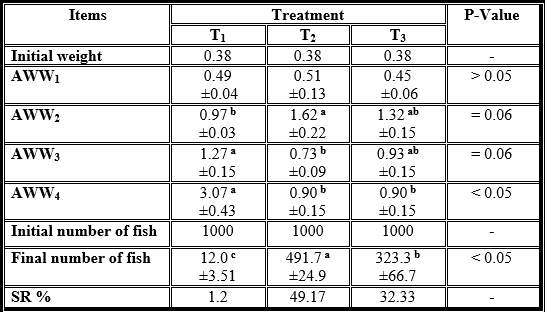

From the obtained results, it could conclude the beneficial use of commercial African catfish hatcheries to the middle frequency of grading (grading hatched fry each 3 days), which realized the best survival rate and the highest fry body weight than without grading or grading each 7 days, respectively. Therefore, the economic efficacy (from selling the fry) could be improved by the same rate.
July 2014




